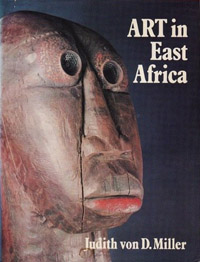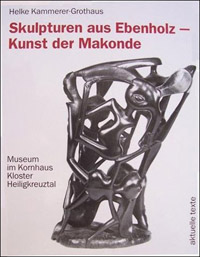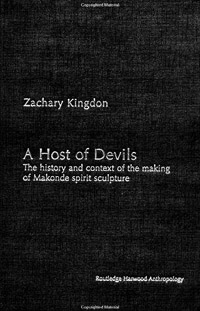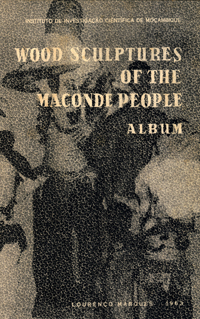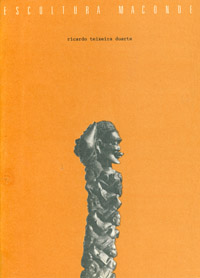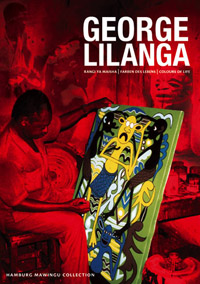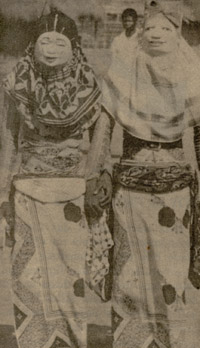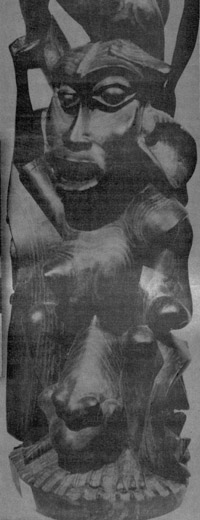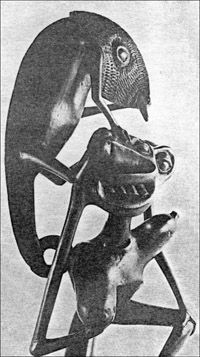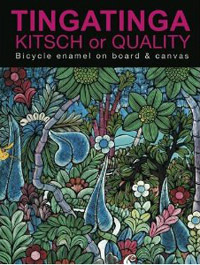Makonde Art: Carving and Painting
Dossier MZ-0039 [Part 4]
![]()
The Makonde [Portuguese: Maconde] people live on both sides of the Rovuma river in northern Mozambique (mainly in Cabo Delgado province) and southern Tanzania, with an estimated total population of about 1.4 million people. They have been studied in detail by such anthropologists as the Portuguese António Jorge Dias (1907-1973) during the colonial period, the US anthropologist Harry West, author of Kupilikula: governance and the invisible realm in Mozambique (Chicago: University of Chicago Press, 2005), and most recently by the Italian scholar Paolo Israel, whose website is available here.
The Makonde are well-known as prolific producers of masks and carvings, and of paintings in related naïf genres, of which the tourist-oriented «Tingatinga» style may be the best known. The mapiko masks are used in ritual dances; the carvings of mashetani (or malevolent spirits) and other subjects are commonly for the tourist trade, and paintings are often similarly a kind of ‘airport art’. Nevertheless, both sculptors and painters of significant artistic quality operate within this compromised tradition, and in revolutionary Mozambique in the 1970s and the 1980s Makonde sculpture especially was taken seriously, as the articles from Tempo and Domingo presented below under MHN Resources clearly show. For a more recent discussion that challenges «the persistence of polar descriptors such as ‘authentic’ and ‘commercial’ [as well as] the deeper dichotomy between ‘traditional’ and ‘modern’…», see the article by West and Sharpes, linked below.
The MHN resources presented here consist of articles from the Maputo weeklies Tempo and Domingo on Makonde art, including interviews and analyses. The Makonde artistic tradition – from the geographical heartland of the independence struggle – seems to have provided Frelimo with an authentically African aesthetic for nationalist purposes, even though there was presumably some discomfort with the «obscurantismo» of the beliefs that originally underpinned its practices.

Above: Mestre Matias Ntundo, a Makonde woodcut artist (Portuguese: xilogravura). Ntundo once remarked that tourists «buy shetani works because they like to think they are buying … the creativity, the very thoughts, of the sculptor himself [quoted by West and Sharpes, linked below].
![]()
MHN Resources
◊ 1975
Judith von D. Miller. Art in East Africa: a guide to contemporary art (London: F. Muller, 1975), pages 31 et seq. Click here to download a PDF file, size xx kb. A short section on Makonde art mainly based on Tanzania.
◊ 24 December 1978
Alexandrino José. A ideia esculpida. Tempo [Maputo] no.429 (24 December 1978), p.24-29. In Portuguese. Click here to download a PDF file, size 2.5 Mb. An article written on the occasion of an exhibition of Makonde carving at the National Art Museum.
◊ 25 September 1983
Ricardo Duarte. Escultura maconde: encontro da arte com a vida. Tempo [Maputo] no.676 (25 September 1983), p.43-47. In Portuguese. Click here to download a PDF file, size 1.7 Mb. First of a three-part series.
◊ 9 October 1983
Ricardo Duarte. Escultura maconde: encontro da arte com a vida [conclusão]. Tempo [Maputo] no.678 (9 October 1983), p.50-53. In Portuguese. Click here to download a PDF file, size 2.6 Mb. Last of a three-part series.
◊ 2 September 1984
Arte makonde procura ganhar mercados. Domingo [Maputo] (2 September 1984). In Portuguese. Click here to download a PDF file, size 510 kb.
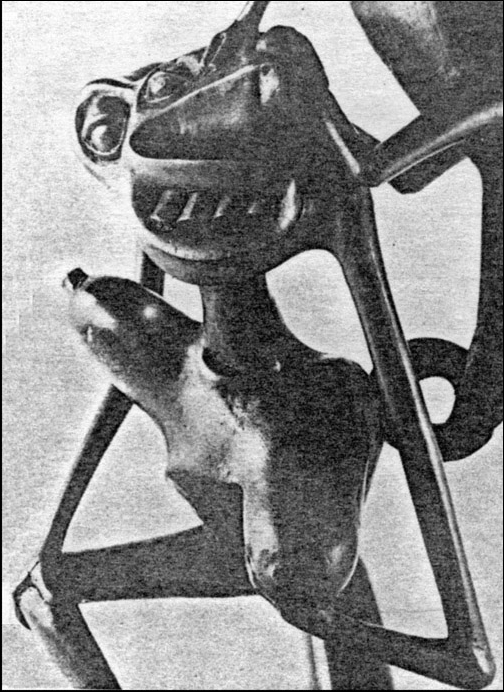
Above: Detail of a carving of a shetani, a common theme in Makonde art. Belief in mashetani is widespread in East Africa and they are often represented as grotesquely distorted human or animal figures. The word comes from the same Hebrew/Arabic root as the English Satan, but mashetani are by no means simply demons.
◊ 22 September 1984
Arte maconde exposta em Nova Iorque: semana passada esteve em Paris. Notícias [Maputo] (22 September 1984). In Portuguese. Click here to download a PDF file, size 37 kb.
◊ 2 December 1984
Alberto Naroromele. País sem cultura é terra sem gente: Matias Ntundu Mzaanhoka, artista moçambicano de xilogravura. Domingo [Maputo] (2 December 1984), p.16. Click here to download a PDF file, size 272 kb.
◊ 22 December 1985
Ernesto Cassimuca. Cabo Delgado: investigar cultura popular. Tempo [Maputo] no.793 (22 December 1985), p.53-55. In Portuguese. Click here to download a PDF file, size 3.1 Mb.
◊ 13 April 1986
Mário Ferro. Samora Machel oferece material a quatro escultores. Domingo [Maputo] (13 April 1986). In Portuguese. Click here to download a PDF file, size 477 kb.
◊ 4 May 1986
Alberto Naroromele. Artista não tem patrão: três mestres de arte maconde em conversa com o «Domingo». Domingo [Maputo] (4 May 1986). In Portuguese. Click here to download a PDF file, size 289 kb.
◊ 21 December 1986
Alberto Naroromele. Matias Ntundo: escrever a história no pau-preto. Domingo [Maputo] (21 December 1986). In Portuguese. Click here to download a PDF file, size 367 kb.
◊ 17 June 2001
Celeste Bié. Pirataria ameaça arte maconde: queixam-se os artistas de pau-ferro. Domingo [Maputo] (17 June 2001), p.14. In Portuguese. Click here to download a PDF file, size 461 kb.
![]()
Links
◊ Autumn 2002
Harry G. West and Stacy Sharpes. Dealing with the devil: meaning and the marketplace in Makonde sculpture. African Arts vol.35 no.3 (Autumn 2002), pages 32-39. Click here for a PDF file [requires subscription].
◊ George Lilanga (1934-2005) was an important Tanzanian painter, sculptor and artist in the Makonde tradition, who lived and worked in Dar es Salaam. This Hamburg-based website presents an authoritative overview of his work. Click here to jump to the site.
◊ The Anaikala website – intended «to diffuse his work as an anthropologist in Northern Mozambique and elsewhere» – is the creation of the Italian scholar Paolo Israel, and contains copies of his publications as well as reflections on his fieldwork in Cabo Delgado. Israel’s book based on his French Ph.D. dissertation is due to be published in the near future. Click here to go to the site.
◊ Lots of photographs of Makonde objets d’art by the sculptor Ntaluma, available on this Portuguese-language site, here.
![]()
Video Material
Above: a very short video of an exchange in English between an American woman (off-screen) and an unidentified carver, who explains that he sandpapers the wood smooth and then applies shoe-polish (‘Kiwi’) to the black parts, to make them ‘shiny’. This adds little to our understanding at any level, but successfully typifies the character of the airport art industry.
Above: A three-minute video-clip without spoken commentary, which shows carvers at work; there is sufficient footage for the viewer to get some sense of the skills involved. The film also includes a couple of very brief moments of mapiko dancing, and a travel sequence at the beginning.
![]()



![Aluka: Struggles for Freedom [subscription required] Struggles for Freedom](imgs/aluka_200.png)



